OnePlus 8T Review
OnePlus 8T Review
A new definition of speed
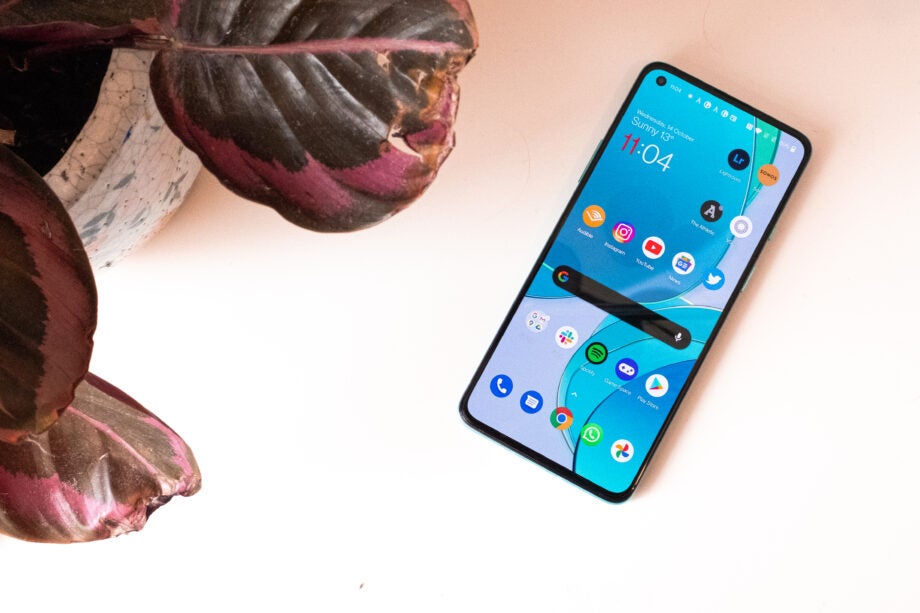
Verdict
If you want pure performance, an excellent screen and some of the fastest charging around then the OnePlus 8T should be near the top of your list. The lower than usual for a flagship price makes it an even more tempting prospect.
Pros
- Lovely display
- Seriously fast charging
- A performance champion
- Already on Android 11
Cons
- No IP rating
- No wireless charging
- Fairly useless secondary cameras
Key Specifications
- Review Price: £549
- 6.55-inch 120Hz OLED
- Snpadragon 865
- 8/12GB RAM + 128/256GB storage
- 65w charging
- 48MP main rear camera
With the OnePlus 8T coming on the heels of the great Nord, OnePlus is once again focussing on the midrange market that made it successful to begin with.
There’s no OnePlus 8T Pro this year, leaving the 8T as the sole mid-cycle update for the brand’s flagship device. Considering how good the 8T is, that’s fine by me.
The OnePlus 8T will cost £549 for the 8GB/128GB model and £649 for the 12GB/256GB version.
Screen and Design – The best of OnePlus
The OnePlus 8T is the sort of phone the brand should be making. After a few years of split loyalties between a standard and Pro version, the OnePlus 8T stands alone and does a good job at satisfying both audiences.
Take the screen, for instance. This is a fantastic 6.55-inch OLED 120Hz panel, without the pesky overly curved sides of the OnePlus 8 Pro. The FHD+ resolution is not as sharp as some of the competition, but it’s still supremely colourful with DCI-P3 gamut support and very bright. OnePlus claims it can hit over 1100 nits of brightness and that figure doesn’t sound wrong.
The 120Hz refresh rate, higher than the 90Hz on the OnePlus 8 and 60hz of the iPhone 11, is the star though, giving everything a smooth finish. It would have been nice if OnePlus had taken a page from Samsung’s book and allowed the refresh rate to ramp up and down depending on what you’re doing, but it doesn’t. It’ll either stay at 120Hz or 60Hz. A 240Hz sampling rate makes for more precise and responsive gaming too.
Related: Best mid-range phones
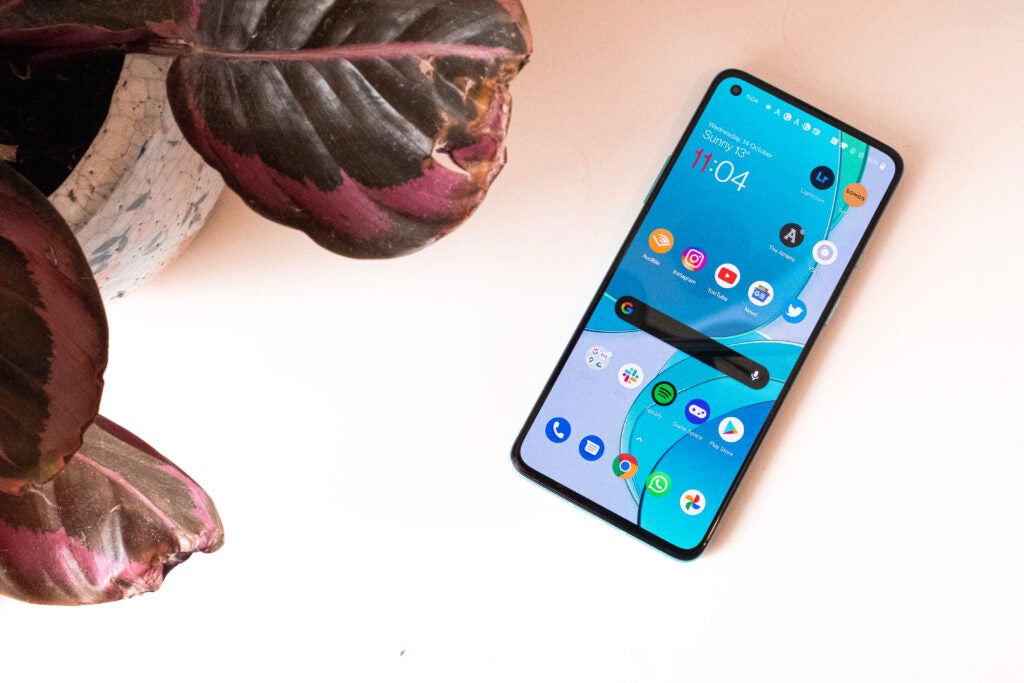
It’s a large display, and covers the majority of the phone’s front. There’s a small cut out for the front camera and a slightly chunkier bezel under the display – but neither of these ruin the immersion of such an excellent panel.
Flip the phone over and you’ve got a Gorilla Glass 4 back, with a new rectangular camera housing. The back isn’t matte, but whatever covering OnePlus has added does a great job at reducing the prevalence of smudges and fingerprints. That’s especially obvious on this blue (or Aquamarine, as OnePlus calls it) hue.
The colour itself is bright and catches the light nicely. There’s a less ostentatious grey/silver model too. It would have been nice for OnePlus to bring back its classic Sandstone finish here to help differentiate the OnePlus 8T, but at least you can still get that finish in case form.
It’s good to see the sides are still aluminium for added rigidity. On the other hand, the lack of an official IP rating is a shame (but not altogether surprising) and there’s no headphone jack either. Neither of these is a deal breaker and often par for the course at this price.
What you do have around the sides is a clicky volume rocker, ring slider that’s ace for easily slipping into silent mode and a USB-C port on the bottom.
Performance – Fast chip, huge amounts of RAM and plenty of storage
Most phones in the OnePlus 8T’s price range go for the Snapdragon 765G (Pixel 5, for example) rather than a top-end chipset in order to save money, however that’s not a move OnePlus has made.
Like the Samsung Galaxy S20 FE, the 8T uses the high-end Snapdragon 865 (not the more graphically-capable Plus version) and pairs that with either 8GB or 12GB of LPDDR4X RAM. I’ve been using the 12GB model and while it’s probably overkill, there’s no doubting it makes for a seriously smooth phone. Storage is healthy too, at either 128GB or 256GB. In typical OnePlus style, there’s no microSD slot so choose your storage capacity wisely.
The combination of the 865 chip, 12GB of memory and 120Hz screen put the OnePlus 8T up there with the fastest phones around. It can handle anything you throw at it, from intensive games on their highest graphical settings to heavy image editing. It stays perfectly cool too and the only time it got hot was during the initial setup when hundreds of apps were installing.
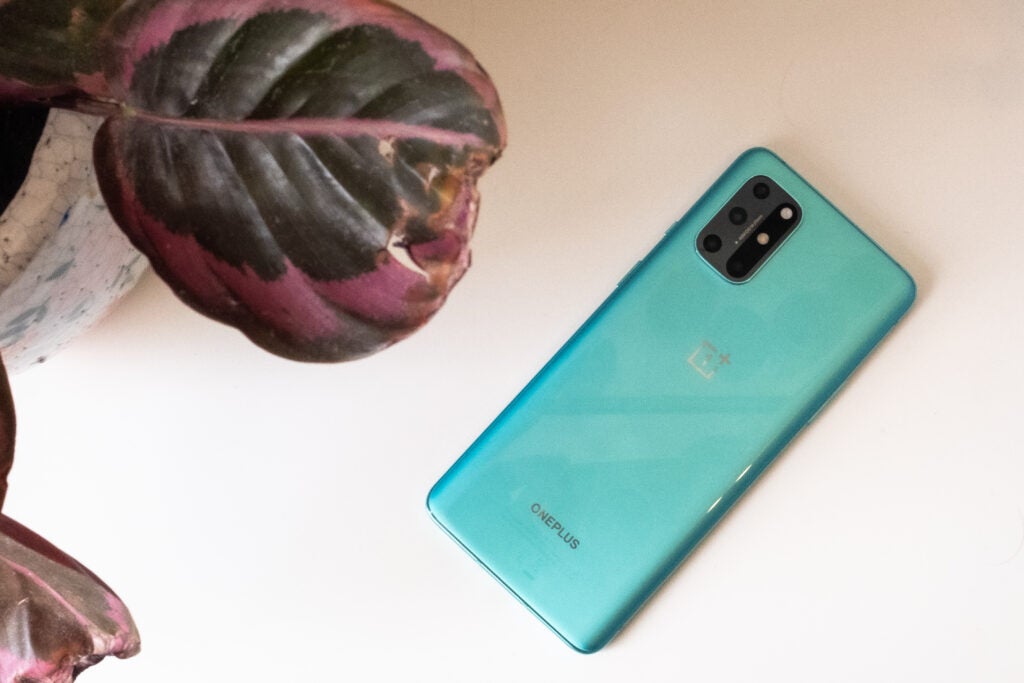
The OnePlus 8T is a 5G phone, like all of the OnePlus phones this year. If you’re in a 5G area, on the right plan and with a capable SIM (the likelihood is that your SIM is already 5G capable) then you will be able to reap the new tech’s benefits. While I wouldn’t recommend upgrading just to get 5G, as it gets more common and faster the compatibility will be nice to have.
Related: What is 5G?
Outside of this, you’ve got WiFi 6 support, good call quality and adequate speakers. Pretty much everything you’d expect from a OnePlus phone. There’s a fingerprint sensor inside the display that’s fine – it’s quick, though not that reliable and face unlock.
Software – OnePlus moves away from its ‘stock’ Android roots and it’s for the best
When OnePlus first unveiled its new OxygenOS version based on Android 11, I read a lot of negative opinions about it. This is quite a big departure from the once very ‘stock’ look of previous iterations and that seemed to have irked many. But the fact of the matter is that even Google’s own Pixel phones now run very different launchers than what was once considered stock Android.
The new software here bares more than a passing resemblance to the OneUI you’ll find on Samsung phones. Not necessarily in terms of design, but there’s a similar focus on making more of the display real-estate and moving UI elements into more accessible positions.
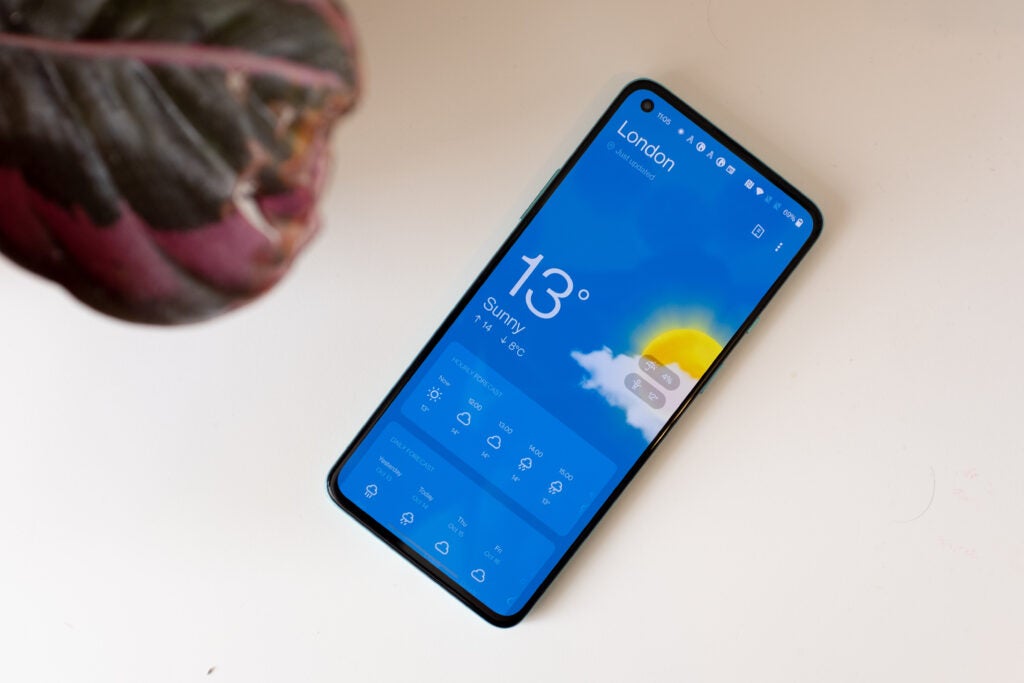
I like the look of the software and it packs a number of genuinely great features. The native apps are far better than before, there’s still a good reliance on Google services and finally you’ve got an option for an always-on display.
The reader mode that turns apps like Kindle monochrome is thankfully still around and you can now swipe down from the homescreen to access a handy panel filled with widgets and shortcuts. It all feels very well designed and easy to use.
OnePlus has also shown itself skilled at getting yearly Android updates out quickly and the OnePlus 8T is one of the first phones that isn’t a Pixel to come with the new version of Google’s OS.
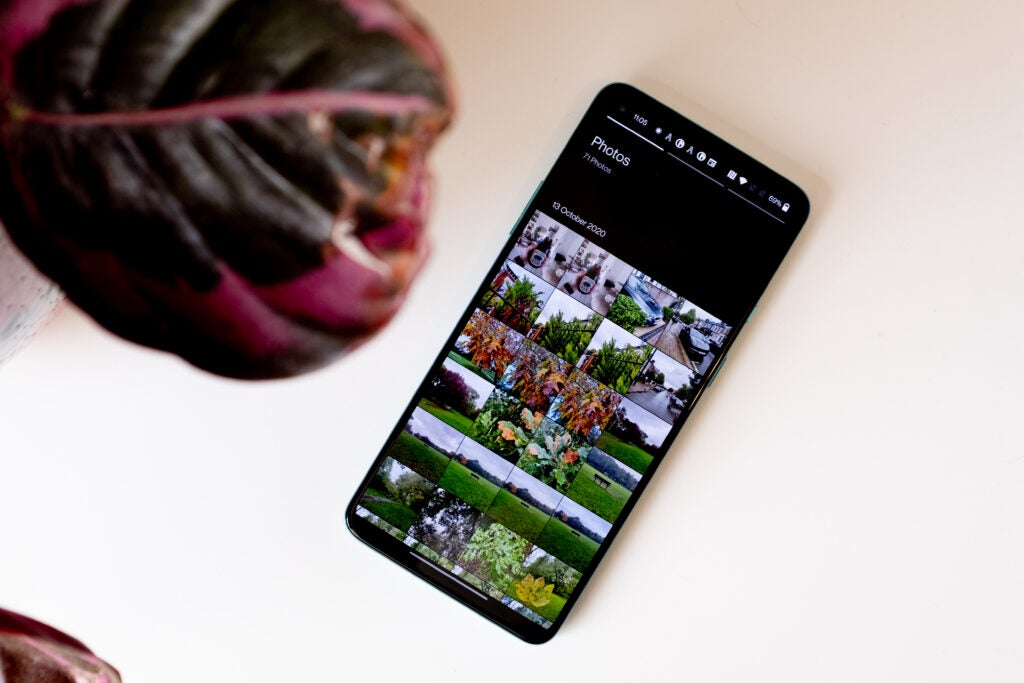
Camera – The OnePlus 8T takes good photos and has a lot of modes
OnePlus phones’ cameras have never truly impressed me. They’ve not been bad, but it’s always felt like more time was spent elsewhere rather than fine-tuning the photography experience. It’s more of the same here: the 8T can take good looking snaps that have a real social-media pop, it has a load of features and focal lengths and is very fast to use. But if camera performance is your biggest desire then you might be better off looking at the Pixel 4a or 5.
Related: Best camera phones
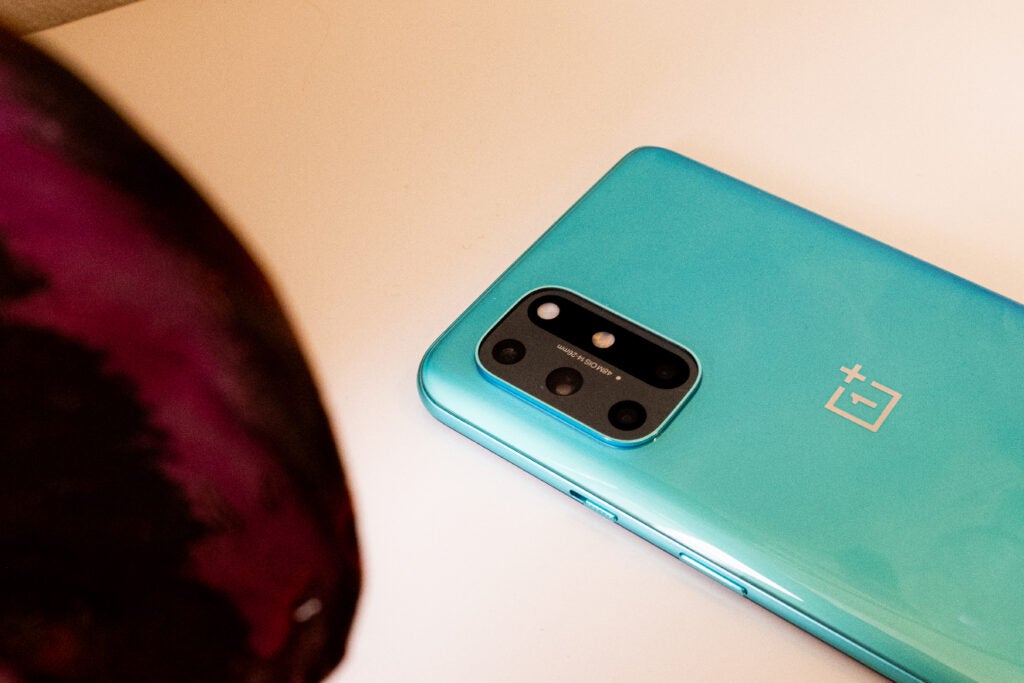
With the OnePlus 8T you’ve got a bevvy and sensors and lenses. There’s a main 48MP Sony IMX586 (that’s the same as you’ll find in the OnePlus 8) with OIS and an f/1.7 aperture; a 16MP ultra wide; a 5MP macro for close-up shots and a 2MP monochrome lens.
Let’s start with the main sensor. The snaps from this camera are good, with a heavy reliance on strong HDR effects for a very social-media friendly result. If you’ve got a shot with lots of competing (the cloudy landscapes below) elements, you’ll have real standout colours that can often look a bit unnatural. There’s definitely some smoothing going on in the post-processing too, which is obvious when you zoom in. Still, most of the shots are I got were decent and the camera is reliable.

Colours are strong and there’s plenty of detail in the 12MP shots
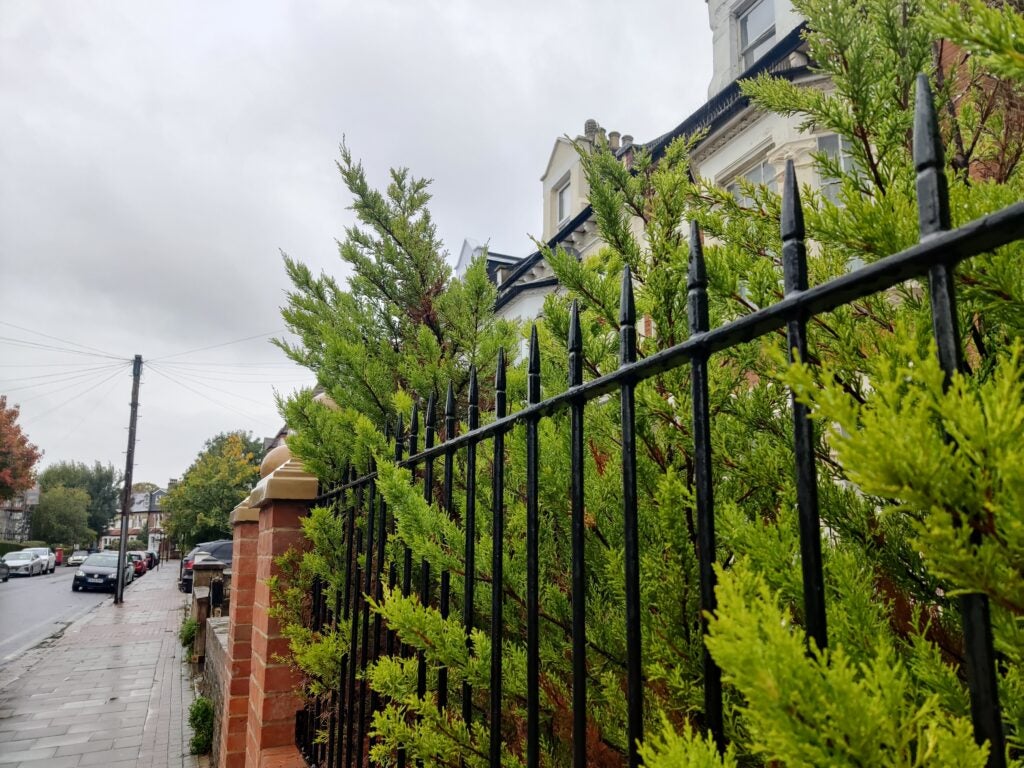
Colours can have a tendency to look a little too vivd – take this green, it wasn’t this bright in real life

You get a nice natural background blur
There’s a low light shooting mode that adds a lot more brightness – sometimes too much – and this is good if the situation is really dark.
The ultra wide camera is good too. The view is far wider than the Pixel 5 and while the colours and processing aren’t exactly the same, they are good enough for day to day casual snappers.

The ultra wide is very wide
I have less good things to say about the other sensors. The 5MP macro sensor is nothing but a gimmick, while the monochrome sensor just turns photos black and white. The results don’t look much better than using a simple filter. These two ‘cameras’ don’t need to be here.
Video shooting is much the same as it was on the OnePlus 8 (4k 60, FHD 480fps). There is some improved stabilisation and a new video portrait mode that blurs the background, but the latter is a little hit-and-miss, just as it has been on every phone that’s tried it.
Battery life – A full charge in 40 minutes changes how you think about battery life
Battery life is, on the whole, very good, but it’s the phone’s seriously impressive charging skills that stand out more.
You can fully charge a completely depleted OnePlus 8T is about 40 minutes and get 50% in less than 20. This speed is achieved by having dual batteries inside the phone that charge independently from one power source.
Of course, you will need to use the, rather bulky, 65w brick to get these speeds. Thankfully this charger is also powerful enough to charge some laptops or a Nintendo Switch so it’s handy to have around.
Those two internal cells add up to a 4500mAh capacity and the OnePlus 8T can make it through the day, averaging more than six hours of screen on time. That’s with the 120Hz screen option, but no 5G.
Related: Best phones
I have found my attitude to charging change since putting my SIM into the OnePlus 8T. A quick 15 minute charge while I am having a shower in the evening means I won’t have to charge it the next day or if I forget that then a quick plug in while I am making my morning coffee. We’ve had quick charging for ages now, but this is the next step.
OnePlus isn’t the first to introduce this and it won’t be the last. The tech is likely using the same smarts that Oppo uses in its Super VOOC charging. Oppo and OnePlus sit under the same umbrella company and Realme (another brand in the same situation) uses it too under a different name. Qualcomm has already announced its own plans too, with the next-gen Quick Charge standard bringing much faster charging to a wider array of phones.
The only real downside is that lack of Qi wireless charging. You’ll need the OnePlus 8 Pro for that.
Should you buy the OnePlus 8T?
If you want pure performance, an excellent screen and some of the fastest charging around then the OnePlus 8T should be near the top of your list. The lower than usual for a flagship price makes it an even more tempting prospect.
How we test phones
We test every mobile phone we review thoroughly. We use industry standard tests to compare features properly and we use the phone as our main device over the review period. We’ll always tell you what we find and we never, ever, accept money to review a product.


